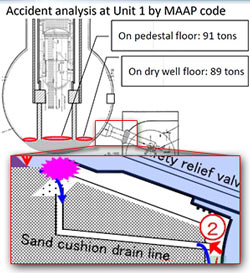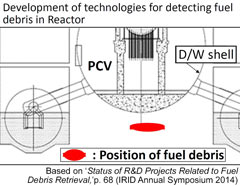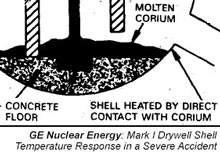
Document shows nuclear fuel burned through bottom of containment vessel under Fukushima reactor — Official: Leakage we observed indicates melt-through by ‘shell attack’ — “This is a very big problem… fuel debris in the PCV is doing something bad” (VIDEO)
ENE News
• Part 30 – “This is the current situation… This is Unit No.  1, this shows the the lower part of the PCV [primary containment vessel]… Based on the results of research so far… the ‘sand cushion drain’… water is leaking here, which means that this section above there is damaged — so that is highly possible. Therefore, this is a very big problem, because if this is damaged, then one possibility is that shell attack has happened [see drawing by General Electric at bottom right]. So the debris in the PCV is doing something bad to this, so we have to take that into consideration for investigation.”
1, this shows the the lower part of the PCV [primary containment vessel]… Based on the results of research so far… the ‘sand cushion drain’… water is leaking here, which means that this section above there is damaged — so that is highly possible. Therefore, this is a very big problem, because if this is damaged, then one possibility is that shell attack has happened [see drawing by General Electric at bottom right]. So the debris in the PCV is doing something bad to this, so we have to take that into consideration for investigation.”
• Part 31 – “Unit 2… the water level [in the suppression chamber] and the water level in the torus room is about the same . What that means is that at the bottom [of the S/C], there could be a hole. Not only there, but also there is a pump room and there are other pipings here, so that needs needs to be considered as well when they conduct the investigation.”
• Part 42 – “Unit 1… there is little fuel remaining in the core… Fuel debris exists even outside the pedestal. Therefore we give priority to outside pedestal investigation. I talked about suppression  chamber earlier, shell attack has happened perhaps — I said that — shell attack in Unit 1 is something like this. Debris may exist around here so… there is some fuel that has penetrated outside the pedestal… If debris is outside the pedestal we can’t reach it, therefore we have to consider opening a side area – it’s very unique… Regarding Unit 2 and 3… in Unit 3 we presume that more fuel than we expected has fallen down to the PCV… we cannot deny the possibility that fuel has gone outside the pedestal.”
chamber earlier, shell attack has happened perhaps — I said that — shell attack in Unit 1 is something like this. Debris may exist around here so… there is some fuel that has penetrated outside the pedestal… If debris is outside the pedestal we can’t reach it, therefore we have to consider opening a side area – it’s very unique… Regarding Unit 2 and 3… in Unit 3 we presume that more fuel than we expected has fallen down to the PCV… we cannot deny the possibility that fuel has gone outside the pedestal.”
• Part 55 – “This is a MAAP example [computer code used for estimating fuel debris position]. Improvement points… the height is increasing, we had a single transfer path [for the molten fuel], but it is going to be  multiple paths. And also debris, a uniform debris deposit was the assumption, now however asymmetrical distribution has to be considered. And also debris below the PCV bottom [see TEPCO drawing at middle right], the behavior has to be considered.”
multiple paths. And also debris, a uniform debris deposit was the assumption, now however asymmetrical distribution has to be considered. And also debris below the PCV bottom [see TEPCO drawing at middle right], the behavior has to be considered.”
• Part 95 – “The level of damage is high so it may not be able to stop water… and it may not be possible to fully cover the fuel debris. In such a case innovative approaches could be considered.”
And: Image published by embassy in Japan shows Fukushima melted fuel deep underground
Watch Suzuki’s presentation here
Published: July 13th, 2015 at 10:24 am ETBy ENENews |
